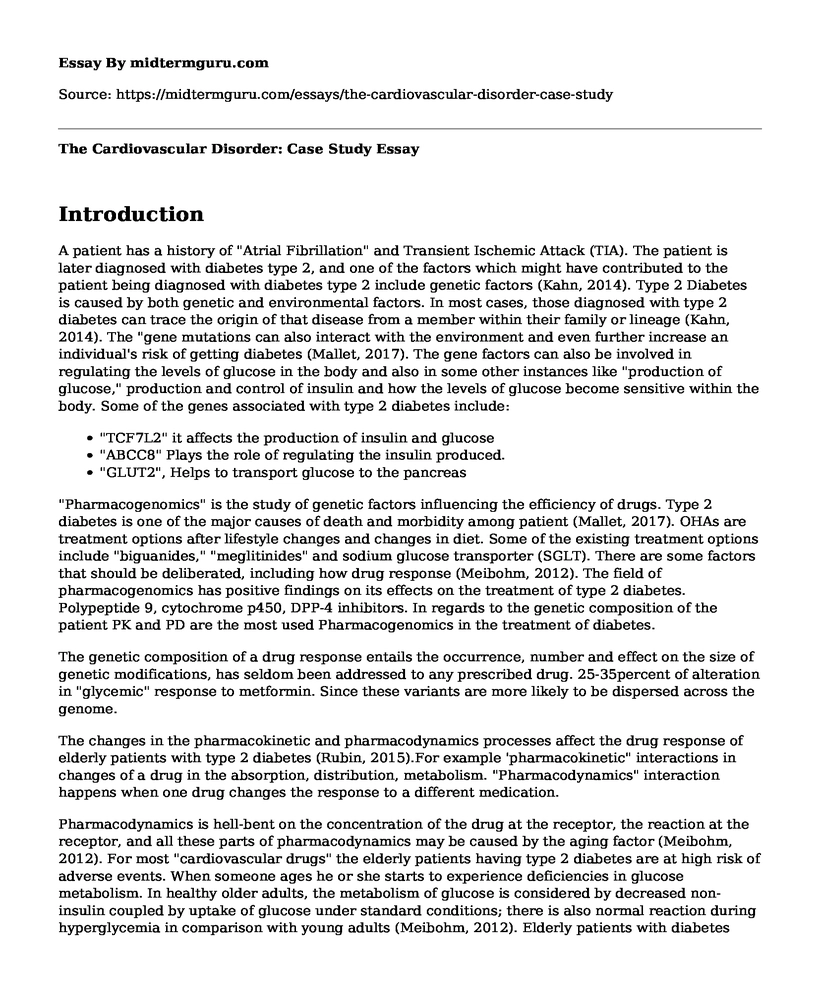Introduction
A patient has a history of "Atrial Fibrillation" and Transient Ischemic Attack (TIA). The patient is later diagnosed with diabetes type 2, and one of the factors which might have contributed to the patient being diagnosed with diabetes type 2 include genetic factors (Kahn, 2014). Type 2 Diabetes is caused by both genetic and environmental factors. In most cases, those diagnosed with type 2 diabetes can trace the origin of that disease from a member within their family or lineage (Kahn, 2014). The "gene mutations can also interact with the environment and even further increase an individual's risk of getting diabetes (Mallet, 2017). The gene factors can also be involved in regulating the levels of glucose in the body and also in some other instances like "production of glucose," production and control of insulin and how the levels of glucose become sensitive within the body. Some of the genes associated with type 2 diabetes include:
- "TCF7L2" it affects the production of insulin and glucose
- "ABCC8" Plays the role of regulating the insulin produced.
- "GLUT2", Helps to transport glucose to the pancreas
"Pharmacogenomics" is the study of genetic factors influencing the efficiency of drugs. Type 2 diabetes is one of the major causes of death and morbidity among patient (Mallet, 2017). OHAs are treatment options after lifestyle changes and changes in diet. Some of the existing treatment options include "biguanides," "meglitinides" and sodium glucose transporter (SGLT). There are some factors that should be deliberated, including how drug response (Meibohm, 2012). The field of pharmacogenomics has positive findings on its effects on the treatment of type 2 diabetes. Polypeptide 9, cytochrome p450, DPP-4 inhibitors. In regards to the genetic composition of the patient PK and PD are the most used Pharmacogenomics in the treatment of diabetes.
The genetic composition of a drug response entails the occurrence, number and effect on the size of genetic modifications, has seldom been addressed to any prescribed drug. 25-35percent of alteration in "glycemic" response to metformin. Since these variants are more likely to be dispersed across the genome.
The changes in the pharmacokinetic and pharmacodynamics processes affect the drug response of elderly patients with type 2 diabetes (Rubin, 2015).For example 'pharmacokinetic" interactions in changes of a drug in the absorption, distribution, metabolism. "Pharmacodynamics" interaction happens when one drug changes the response to a different medication.
Pharmacodynamics is hell-bent on the concentration of the drug at the receptor, the reaction at the receptor, and all these parts of pharmacodynamics may be caused by the aging factor (Meibohm, 2012). For most "cardiovascular drugs" the elderly patients having type 2 diabetes are at high risk of adverse events. When someone ages he or she starts to experience deficiencies in glucose metabolism. In healthy older adults, the metabolism of glucose is considered by decreased non-insulin coupled by uptake of glucose under standard conditions; there is also normal reaction during hyperglycemia in comparison with young adults (Meibohm, 2012). Elderly patients with diabetes always have a deficiency in the uptake of glucose and also weaker uptake reaction during hyperglycemia. The age-related physiological changes in glucose metabolism and enhanced risk for hypoglycemia have significant effects for the pharmacological treatment of diabetes especially type 2 diabetes.
The ADA (American Diabetes Association) enhances a goal hemoglobin A with diabetes with ("premeal plasma" A1C<7percentage in most individuals) the potential implications of "hypoglycemia" with increased glycemic regulation in older adults, contributing in the responses of hypoglycemia. However, there has been an improvement in the control of glycemic has been demonstrated to decrease the occurrence of diabetes-related diseases like type 2 diabetes in elderly patients significantly.
How to Improve the Drug Plan for Patients
There are several ways of developing the drug plan for patients which include ensuring the patients are given correctly prescribed drugs which will have minimal side effects on their health (Rubin, 2015). Ensuring your drugs are licensed and the outlets where your medications are sourced from are accredited. Putting in place restriction on the misuse of medicine.
References
Kahn, S. E., Cooper, M. E., & Del Prato, S. (2014). Pathophysiology and treatment of type 2 diabetes: perspectives on the past, present, and future. The Lancet, 383(9922), 1068-1083.
Mallet, L., Spinewine, A., & Huang, A. (2017). The challenge of managing drug interactions in elderly people. The Lancet, 370(9582), 185-191.
Meibohm, B., Beierle, I., & Derendorf, H. (2012). How important are gender differences in pharmacokinetics?. Clinical pharmacokinetics, 41(5), 329-342.
Rubin, R. R. (2015). Adherence to pharmacologic therapy in patients with type 2 diabetes mellitus. The American journal of medicine, 118(5), 27-34.
Cite this page
The Cardiovascular Disorder: Case Study. (2022, Sep 12). Retrieved from https://midtermguru.com/essays/the-cardiovascular-disorder-case-study
If you are the original author of this essay and no longer wish to have it published on the midtermguru.com website, please click below to request its removal:
- Patient Safety and Quality Improvement - Paper Example
- Research Paper on Foster Care Subsidies And Social Welfare
- Essay Sample on Theme of AIDS in Movies: Dallas Buyers Club and the Philadelphia
- Standardized Nursing Language: Enhancing Communication & Care - Essay Sample
- Increase Breastfeeding & Improve Infant Health: Invest in Education - Essay Sample
- Nursing Student Striving to Solve Health Problems With Innovations - Essay Sample
- Patients at Risk: Inadequate Data Storage in Hospitals - Essay Sample







